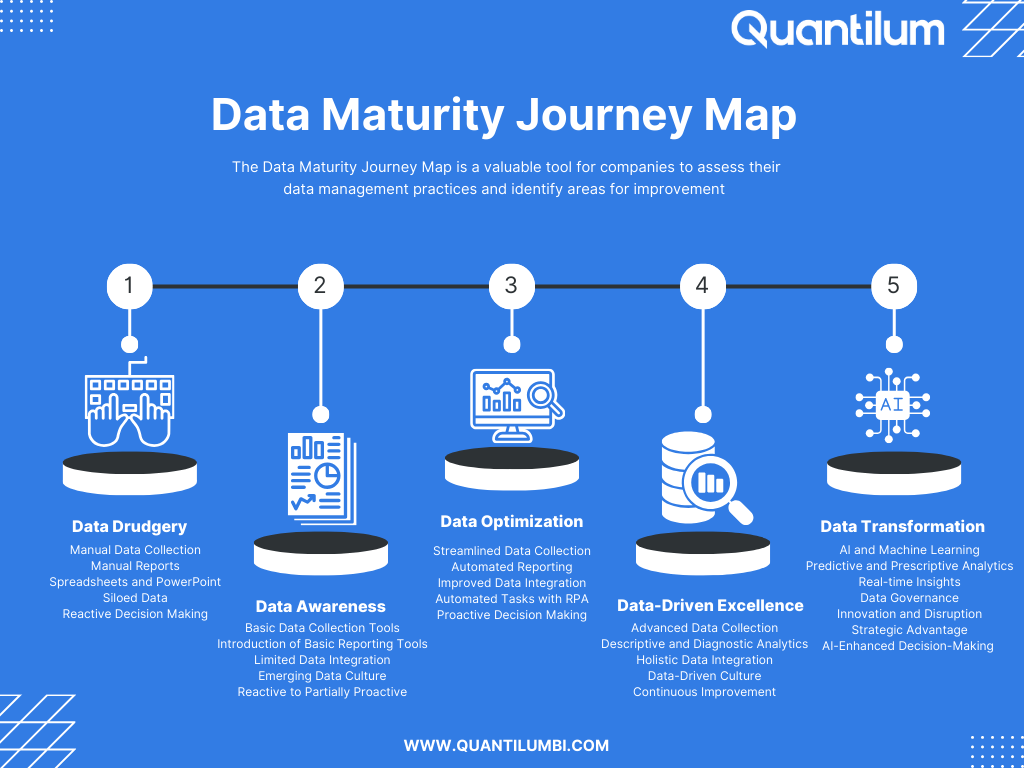In today’s data-driven world, understanding where your organization stands on the data maturity journey is crucial. It’s not just about collecting data; it’s about how you use it to make informed decisions. Let’s explore the stages of this journey and the impact on decision-making.
1️⃣ Data Drudgery (Low Maturity): At this stage, data is manually collected, reports are generated manually, and decisions are often reactive. It’s time-consuming, error-prone, and limits your ability to see the big picture.
- Manual Data Collection: Data is collected manually, often involving pen-and-paper methods or basic data entry.
- Manual Reports: Reports are generated manually using tools like Microsoft Excel or even created from scratch.
- Spreadsheets and PowerPoint: Data is primarily stored and communicated using spreadsheets and PowerPoint presentations.
- Limited Data Integration: Data is siloed and not integrated across different departments or systems.
- Reactive Decision-Making: Decisions are made in response to immediate needs, with limited access to real-time data.
2️⃣ Data Awareness (Low to Moderate Maturity): You begin using digital tools, but manual processes persist. Decision-making shifts from reactive to partially proactive as you start embracing data-driven insights.
- Basic Data Collection Tools: Companies start using digital tools for data collection, but manual processes persist.
- Introduction of Custom Apps: Custom mobile apps are introduced for data collection, reducing manual efforts and improving data accuracy.
- Basic Reporting Tools: The use of basic reporting software or templates begins, reducing the reliance on manual reports.
- Limited Data Integration: Some efforts are made to centralize data sources, but integration is minimal.
- Reactive to Partially Proactive Decision Making: Companies begin transitioning to data-driven decisions, with limited access to real-time data.
3️⃣ Data Optimization (Moderate Maturity): Streamlined data collection, automated reporting, and improved data integration lead to proactive decision-making. You’re on the path to harnessing data for strategic purposes.
- Streamlined Data Collection: Data collection becomes more streamlined with the adoption of custom apps for data collection, reducing manual efforts.
- Automated Reporting: Reporting tools are optimized, enabling automated report generation and distribution.
- Improved Data Integration: Companies start integrating data from various sources, including custom apps, improving data quality and consistency.
- Introduction of RPA: Robotic Process Automation (RPA) is introduced for automating repetitive tasks, enhancing efficiency, and reducing errors.
- Proactive Decision-Making – Decisions are made based on historical data, and the organization is beginning to harness data for strategic purposes.
4️⃣ Data-Driven Excellence (High Maturity): Here, you’ve integrated advanced data collection methods, sophisticated analytics, and holistic data integration. A data-driven culture prevails, influencing every decision you make.
- Advanced Data Collection: Companies use advanced data collection methods, including IoT devices and sensors, in conjunction with custom apps.
- Sophisticated Analytics: Advanced analytics tools are employed for predictive and prescriptive analysis, with data integrated from multiple sources.
- Holistic Data Integration: Data is fully integrated across the organization, enabling a comprehensive view of operations.
- Data-Driven Culture: A culture of data-driven decision-making is embedded, with data influencing all aspects of the business.
- Advanced KPI Dashboards: KPI Dashboards are advanced and offer real-time insights into various aspects of the business, leveraging data from integrated sources.
- Data-Driven Decision-Making – A culture of data-driven decision-making is embedded, with data influencing all aspects of the business.
5️⃣ AI and Machine Learning Integration (Future State): The future holds AI-enhanced decision-making. AI and machine learning optimize resource allocation, provide personalized experiences, and drive innovation, giving you a strategic advantage.
- AI and Machine Learning Adoption: The organization starts integrating AI and machine learning into data processes for advanced predictive and prescriptive analytics.
- Automated Decision Support: AI-driven algorithms assist in making complex decisions, optimizing resource allocation, and enhancing operational efficiency.
- Personalization and Recommendation: AI and machine learning are used to provide personalized customer experiences and product recommendations.
- Innovation and Transformation: AI and machine learning become catalysts for innovation and industry transformation, offering new products and services.
- Strategic Advantage: The organization leverages AI and machine learning as a strategic advantage, staying at the forefront of technological advancements and setting industry standards.
- AI-Enhanced Decision-Making – AI and machine learning are integrated into decision-making processes, providing advanced predictive and prescriptive analytics.
🔗 Why does this matter? Your data maturity level impacts efficiency, accuracy, and innovation. As you progress on this journey, you move from reacting to trends to proactively shaping your future.
🚀 Ready to take the next step? Whether it’s through custom apps for data collection, robotic process automation (RPA) for efficiency, or advanced KPI dashboards for insights, we’re here to guide you on your data maturity journey. Let’s make data work for you!



